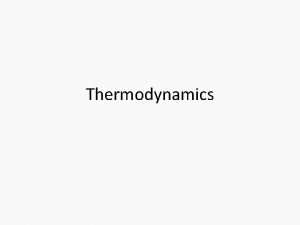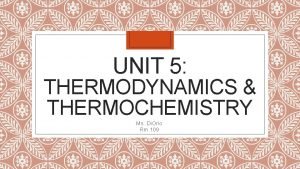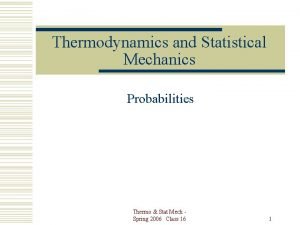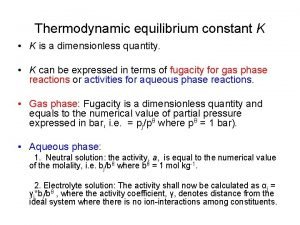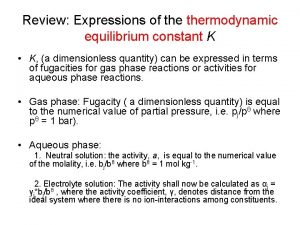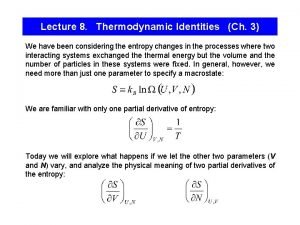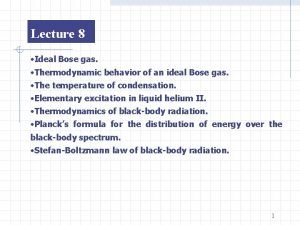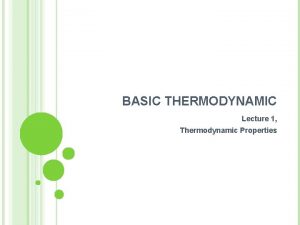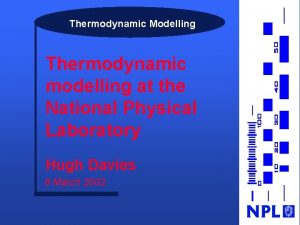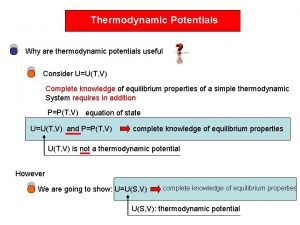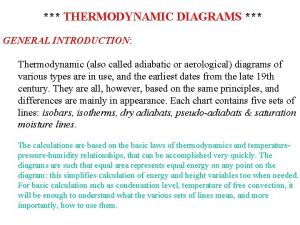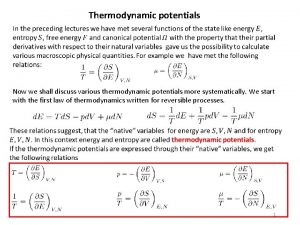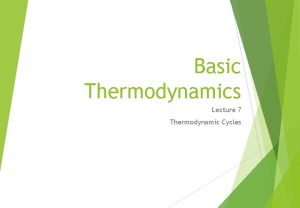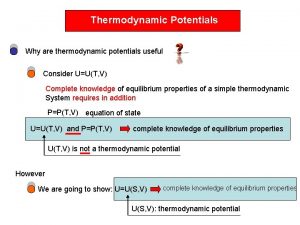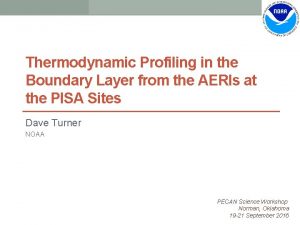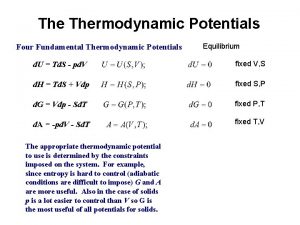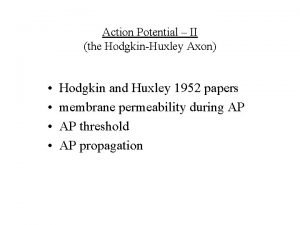HodgkinHuxley and a Thermodynamic Approach Ripley Cleghorn and

















- Slides: 17

Hodgkin-Huxley and a Thermodynamic Approach Ripley Cleghorn and Ferhana Begum Math 390

Action Potential ● Electrical pulse travels down axon of nerve ● Cell communication

Process of Action Potential Resting membrane potential Depolarization Repolarization Hyperpolarization Resting membrane potential

Hodgkin-Huxley Experiment Standard model electrical observances of plasma membrane prove that the plasma membrane was selectively permeable for Na+ and K+ ions

Hodgkin-Huxley Equations ● Cm = membrane as constant capacitor ● gi = channel proteins as resistors ● V m = voltage of the Na+ and K+ currents ● I m = total current ● Ei , = Nernst potential of each ion ● m, n, h = (V ● R = universal gas constant ● F = Faraday’s constant ● T = Temperature ● z = # moles of electrons transferred in cell m , t)

Unclamped PDE of HH During Hodgkin-Huxley experiments, no pulse can propagate Result of “space-clamp” In the unclamped version, the spatial variable, x, is added. Allows us to look at the propagation of the action potential as a traveling wave

Equations of Unclamped PDE Calculated by first combining the total current equation with cable theory eq. Cable theory: voltage along a cylindrical membrane as a function of distance x (as well as resistance) Total current equation combined with cable theory equation yields:

Equations of Unclamped PDE cont. Next, we assume the traveling pulse has a constant speed, . . This allows us to use the wave equation: Combining the wave equation with previous PDE gives us an ODE

Fitzhugh-Nagumo Simpler “reduction” of Hodgkin-Huxley Two variables v - fast, Na+ w - slow, K+

A Thermodynamic Approach Accounts for the nonelectrical effects of action potential that Hodgkin. Huxley model does not heat release and reuptake of heat in cell during AP physical bulge that forms in cell Heimburg and Jackson proposed the solution which considers the action potential as a reversible electromechanical soliton

Thermodynamic Approach cont. Chain-melting is an important part of thermodynamic theory Describes transition of the lipid membrane from solid to liquid Cell membranes are able to carry solitons during this transition (which occurs at body temp)

Thermodynamic Equation where is the change in lateral density of the membrane is the equilibrium lateral density is the velocity of small-amplitude sound is the frequency dependence of the speed of sound (dispersion), and are the parameters determined by density dependence of sound velocity

Thermodynamic Equation cont. By using dimensionless variables, the previous PDE now becomes: After using a coordinate transformation, we get an equation with following solutions:

Thermodynamic Equation cont. Here, is given by: The lower limit to the velocity for the propagation is No solitons exist for slower velocities

Hodgkin-Huxley Vs. Thermodynamic Approach Electrical aspects of AP Dissipative nature Toxins/Drugs Non-electrical aspects of AP No heat dissipation Anesthesia

References Appali, van Rienen, Heimburg. (2012). “A Comparison of the Hodgkin–Huxley Model and the Soliton Theory for the Action Potential in Nerves”. Elsevier Institute, 16, 275 -299. Britton, N. (2012). Essential mathematical biology. Springer Science & Business Media. Heinrich, M. , Dahms, T. , Flunkert, V. , Teitsworth, S. W. , &Schöll, E. (2010). Symmetry-breaking transitions in networks of nonlinear circuit elements. New Journal of Physics, 12(11), 113030. Göktepe, S. , & Kuhl, E. (2009). Computational modeling of cardiac electrophysiology: a novel finite element approach. International journal for numerical methods in engineering, 79(2), 156 -178. “A Sound Theory. (2008). Science Illustrated, 56 -59.

Questions?
 Axel cleghorn
Axel cleghorn Matt damon age
Matt damon age Spatial autocorrelation
Spatial autocorrelation Dawn ripley
Dawn ripley Ripley law
Ripley law Expositori
Expositori Tears of a tiger book summary
Tears of a tiger book summary Numero de ripley despacho
Numero de ripley despacho Martin ripley
Martin ripley The talented mr ripley chapter summary
The talented mr ripley chapter summary Roch ripley
Roch ripley Intensive property and extensive properties
Intensive property and extensive properties Thermodynamic vs kinetic control
Thermodynamic vs kinetic control Microstates in thermodynamics
Microstates in thermodynamics Thermodynamic equilibrium constant
Thermodynamic equilibrium constant Equilibrium constant in thermodynamics
Equilibrium constant in thermodynamics Thermodynamic identity
Thermodynamic identity Thermodynamic behaviour of ideal bose gas
Thermodynamic behaviour of ideal bose gas











